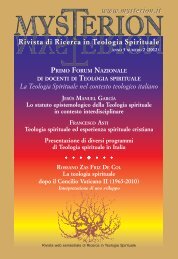Mysterion - rivista di spiritualità e mistica
Mysterion - rivista di spiritualità e mistica
Mysterion - rivista di spiritualità e mistica
You also want an ePaper? Increase the reach of your titles
YUMPU automatically turns print PDFs into web optimized ePapers that Google loves.
www.MYS ERION.it<br />
W.R. STOEGER S.J.<br />
72<br />
1 (2008) 64-77<br />
But how <strong>di</strong>d life arise on Earth? And what were some of the key processes within an<br />
environment rich in heavy elements necessary for further chemical evolution towards<br />
life? We shall probably never know exactly how life first originated on Earth – most<br />
experts realize that that historical event is probably forever inaccessible to our investigations.<br />
However, it has been possible – and is become more and more so – to give an<br />
account or how life may have originated, given what we are <strong>di</strong>scovering about chemistry<br />
and biochemistry and geology. There are various scenarios which have been suggested –<br />
with slightly <strong>di</strong>fferent details. But some of the overall ideas are fairly clear. It is easy to<br />
see that once we have abundances of oxygen, carbon, iron, copper, phosphorous, sulpher,<br />
and all the rest scattered throughout the galaxies by the explosions of dying stars<br />
(supernovae), the interstellar material is now much <strong>di</strong>fferent than it was before. There<br />
are now new con<strong>di</strong>tions, a much richer type of material, upon which the laws of physics<br />
and chemistry can work. New and <strong>di</strong>fferent macroscopic objects and microscopic objects<br />
become not only possible, but inevitable – new types of stars, Jupiter-like planets, rocky<br />
planets, asteroids and comets, crystals and dust of various sorts, and a wondrous variety<br />
of molecules. And with these new objects perva<strong>di</strong>ng the universe, the con<strong>di</strong>tions and<br />
environment in many <strong>di</strong>fferent localities again evolves in something <strong>di</strong>fferent, lea<strong>di</strong>ng in<br />
turn to further new and exciting possibilities.<br />
Once we have planets, asteroids, comets and cool gas clouds surroun<strong>di</strong>ng stars or<br />
near stars, these become the laboratories within which new and more complex molecules<br />
are synthesized – water, ammonia, oxides, nitrides, and even more complex organic<br />
molecules such as formaldehyde, methane, and the more imme<strong>di</strong>ate buil<strong>di</strong>ng blocks for<br />
replicating molecules essential for life, sugars, amino acids, nucleic acids. The key idea<br />
is simple to understand – given certain con<strong>di</strong>tions of temperature (cool but not too<br />
cool!), ra<strong>di</strong>ation, concentrations of certain chemical compounds, equilibrium or nonequilibrium,<br />
the processes yiel<strong>di</strong>ng new molecules will occur in these cool dark clouds,<br />
and on asteroids, comets and planets. And in each case, these new molecules in turn<br />
ra<strong>di</strong>cally alter the existing environment and con<strong>di</strong>tions, and in effect constitute completely<br />
new environments which may in some cases provide the con<strong>di</strong>tions for even further<br />
advances in chemical evolution. And so on.<br />
In fact, these planets, asteroids and gas clouds begin to evolve in their own very<br />
peculiar ways, depen<strong>di</strong>ng on the ever-changing con<strong>di</strong>tions which characterize them – or<br />
characterize regions on them. As planets cool, contract, shift in their structure, develop<br />
atmospheres, undergo episodes of volcanism, are subjected to storms, electrical <strong>di</strong>scharges,<br />
and showers of meteorities and cometary debris, they will change is certain – sometimes<br />
ra<strong>di</strong>cal – ways, as will also the con<strong>di</strong>tions of temperature, chemical composition,<br />
atmosphere, etc. on their surfaces. As certain types of con<strong>di</strong>tions develop, what were<br />
only remote possibilities before now become near certainties, and what were possibilities<br />
before are by-passed and excluded from realization. New regularities and relationships<br />
emerge among the new more complex and more highly organized entities and<br />
systems – regularities and relationships which are thoroughly consistent with the four<br />
fundamental physical forces we talked about in the last talk – but which <strong>di</strong>rectly characterize<br />
the relationships and inherent behavior of the new entities and systems themselves.<br />
None of what happens to any particular system or object is absolutely inevitable.







